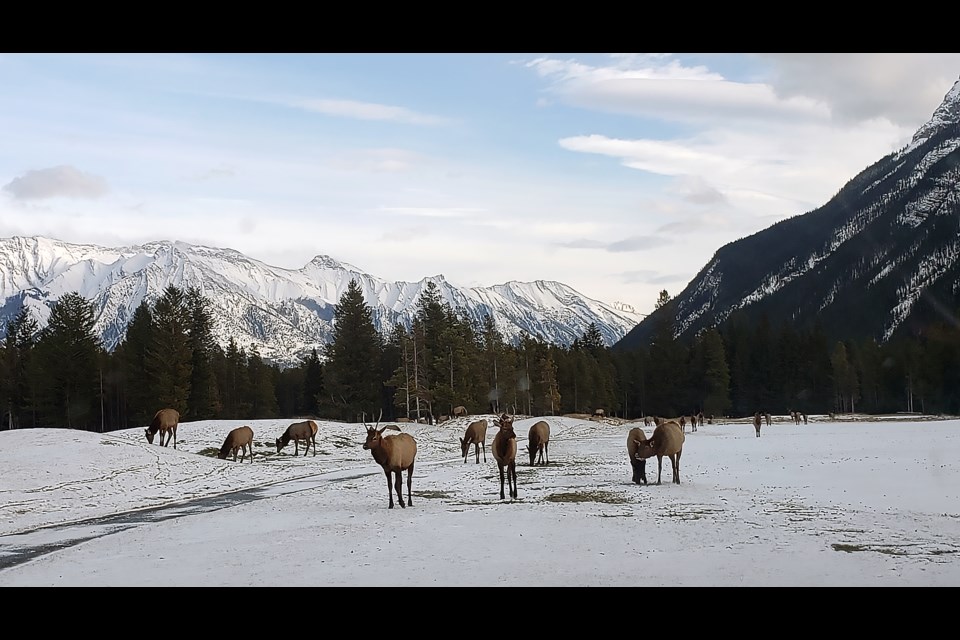BANFF – Banff’s elk population is continuing to decline for the fifth year in a row.
One of two annual surveys in the lower Bow Valley between Castle Mountain and the east gate of Banff National Park, the fall classified count tally was 139 elk in 2022. That compares to 171 in 2021, 212 in 2020, 249 in 2019 and 267 in 2018.
While carnivores such as wolves and cougars are picking off elk and others are struck and killed by trains and vehicles, an acute clostridial bacterial disease discovered in some of Banff’s elk about three years ago continues to kill more individuals.
Wildlife experts say the number of elk has fallen below the healthy population target for the lower Bow Valley of 150 to 300 elk.
“We’re starting to fall a little bit below that, so we’re trying to figure out what’s going on here,” said Blair Fyten, human-wildlife coexistence specialist for Banff National Park.
“We will continue to monitor the elk population closely to see what’s causing this apparent population decline and if it continues.”
For now, the cow-calf ratio of 42 per cent is still not considered a concern, indicating that many elk calves survived last year, including in spring when they are most vulnerable to predators.
However, what is more concerning is that only 81 of the 139 elk were female.
“The females are the ones that produce the offspring and dictate whether you’re going to have an increase or a decrease in your population,” said Fyten.
There were 25 reported elk mortalities in 2022, but there were likely more than that as some carcasses are never found.
Of the 25, three elk died from predation and 10 were struck and killed on the railway or highways. Six died because of clostridial bacterial disease, which is caused by anaerobic bacteria that are widespread in the environment, particularly in soil, and can be fatal.
Fyten said Parks Canada is in the process of redoing its elk management strategy, which was initially developed in the late 1990s.
“We need to probably collar some elk and monitor those collared elk and look at what’s predating on them or killing them or why they are dying and look at cause-specific mortality,” he said.
“We just need to work towards getting a better understanding of cause-specific mortality in order to accurately inform future management options for the long-term sustainability of elk in the park.”
The cases of clostridial bacterial disease discovered in Banff a couple of years ago were all confirmed by necropsies, which are surgical examinations of dead animals.
The disease has also since been detected in Canmore after a sick female elk near the Rundle residential neighbourhood had to be euthanized last summer.
As a predisposing factor, all elk diagnosed with clostridial disease also had giant liver flukes, a naturally occurring parasite long prevalent in elk in Banff National Park and spilling into the Canmore area.
“Over the last couple of years we tend to be finding more of these out there, so it is of some concern,” said Fyten of the Banff elk.
“Obviously, we miss some of that too because these animals, once they get it, it’s quite quick and acute. Some could just drop in the bush and we don’t find them.”
The province of Alberta is not specifically tracking or testing for clostridial disease in elk.
Jason Penner, communications advisor for Alberta Environment and Protected Areas, said the disease is associated with a bacterial infection that gets into the bloodstream of some elk and moose with giant liver fluke infections.
“We’ve seen just three or four confirmed cases of clostridial disease over the past few years, which isn’t a concern from a wildlife management perspective,” he said in an email.
“We really don’t see this disease as a significant risk to elk.”
Another factor that may play out in the future for Banff’s elk population is chronic wasting disease as it continues a steady progression westward, particularly seen along the Bow River corridor northwest of Calgary.
First showing up in Alberta in 2002, it is a fatal disease in the brain of wild and farmed elk, mule deer, white-tailed deer and moose.
Fyten said Parks Canada’s testing program has not discovered chronic wasting disease in Banff yet.
“It’s not that far off the park boundary anymore, but we haven’t detected it here yet,” he said.
“It’s probably just a matter of time before we pick it up in our deer, likely first, and then perhaps our elk.”
According to the province of Alberta’s most up-to-date information, the total number of chronic wasting disease cases detected in wild deer, elk, and moose in Alberta from September 2005 to October 2022 is 4,741 – with 1,156 of those cases being detected in 2021.
Provincial officials say there are significant overall patterns of disease occurrence in Alberta, which continues to occur primarily in mule deer in comparison to white-tailed deer despite testing large numbers of both species. Males are more likely to be infected than females.
“Environment and Protected Areas has not yet finished the 2022 samples,” said Carla Jones, assistant director of communications for Alberta Environment and Protected Areas in an email. “Once completed, the web page will be updated with the 2022 results.”




